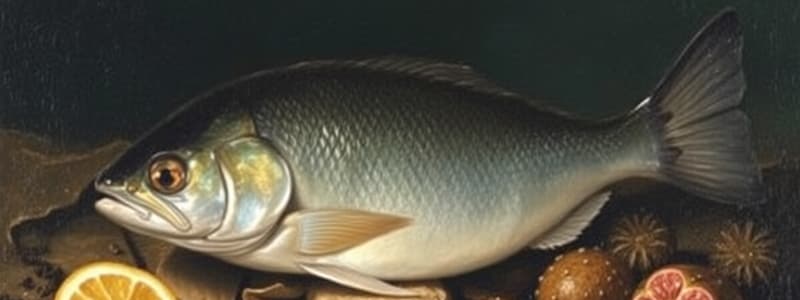Podcast
Questions and Answers
What characteristic distinguishes oily fish from white fish?
What characteristic distinguishes oily fish from white fish?
- Oily fish have fats stored throughout their body. (correct)
- Oily fish contain more protein than white fish.
- Oily fish are exclusively saltwater species.
- Oily fish are always larger than white fish.
Which type of fish is commonly known for having bones that can be eaten?
Which type of fish is commonly known for having bones that can be eaten?
- Catfish
- Tilapia
- Tuna
- Mackerel (correct)
What is a common benefit of long-chain omega-3 fatty acids found in oily fish?
What is a common benefit of long-chain omega-3 fatty acids found in oily fish?
- They help develop a baby's nervous system. (correct)
- They enhance flavor in cooking.
- They increase muscle mass.
- They prevent water retention.
Which of the following is not considered a type of oily fish?
Which of the following is not considered a type of oily fish?
What differentiates round fish from flat fish?
What differentiates round fish from flat fish?
What is a significant health benefit associated with consuming oily fish?
What is a significant health benefit associated with consuming oily fish?
What factors make catfish generally taste 'muddy' in the wild?
What factors make catfish generally taste 'muddy' in the wild?
What is the classification of fish like tilapia?
What is the classification of fish like tilapia?
Flashcards are hidden until you start studying
Study Notes
Classifications of Seafood
- Fin fish have fins and internal skeletons, categorized primarily into oily fish and white fish.
- Oily fish contain long-chain omega-3 fatty acids that may help prevent heart disease and support fetal nervous system development during pregnancy.
Types of Fish
-
Oily Fish
- Examples include salmon, mackerel, sardines, trout, and herring.
- Some oily fish, such as whitebait, canned sardines, pilchards, and tinned salmon, contain edible bones rich in calcium and phosphorus.
- Rich in long-chain omega-3 fatty acids and vitamin D, helping to maintain strong bones and may reduce heart disease risk.
-
White Fish
- Known as "lean fish," with oils concentrated in the liver, removed during gutting.
- Lower in fat compared to red or processed meats; source of omega-3 but in lower levels than oily fish.
- Subdivided into round fish, characterized by a cylindrical body and eyes on each side of the head.
Types of Round Fish
-
Catfish
- A fatty, scaleless freshwater fish common in lakes and rivers; farmed varieties are preferred for flavor.
- Versatile in cooking methods, particularly well-suited for frying.
-
Tuna
- Firm-textured, fatty fish with a mild flavor.
- Varieties include bluefin, yellowfin, bonito, albacore, and mahi-mahi.
-
Tilapia
- Refers to various species of aqua-farmed freshwater fish found globally.
- Notably a lean fish with a firm texture.
Studying That Suits You
Use AI to generate personalized quizzes and flashcards to suit your learning preferences.



